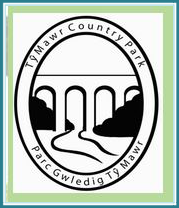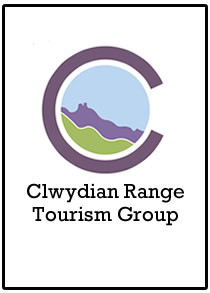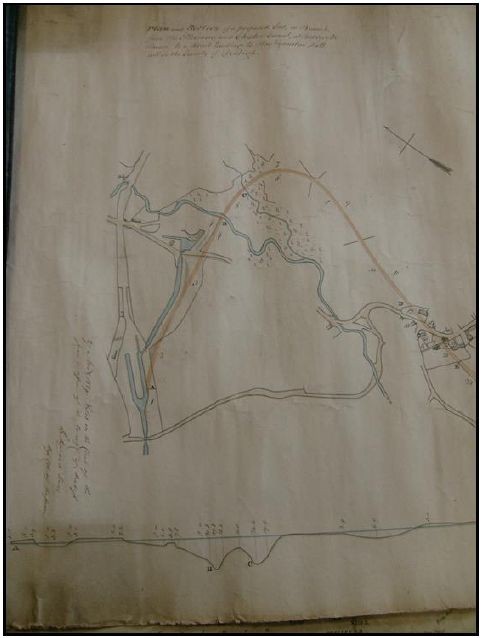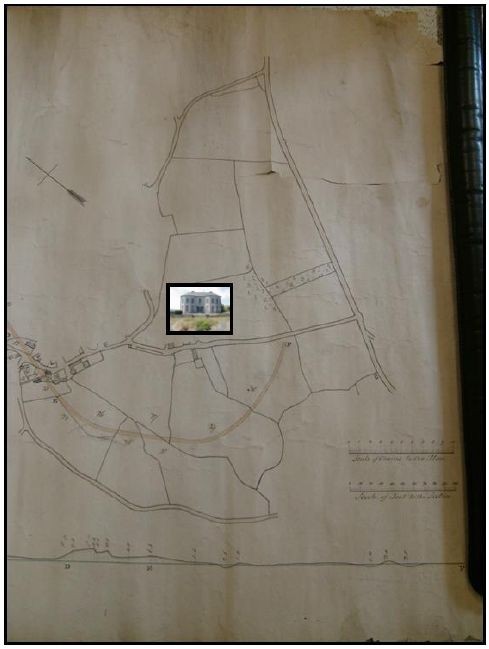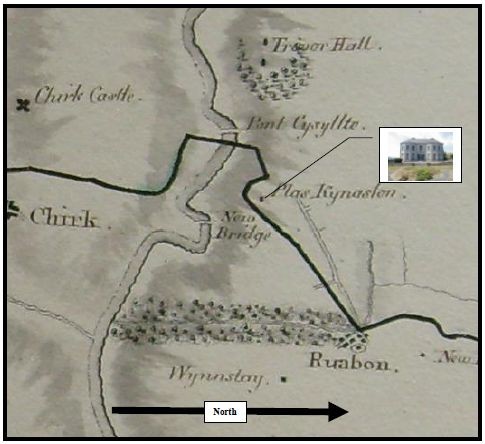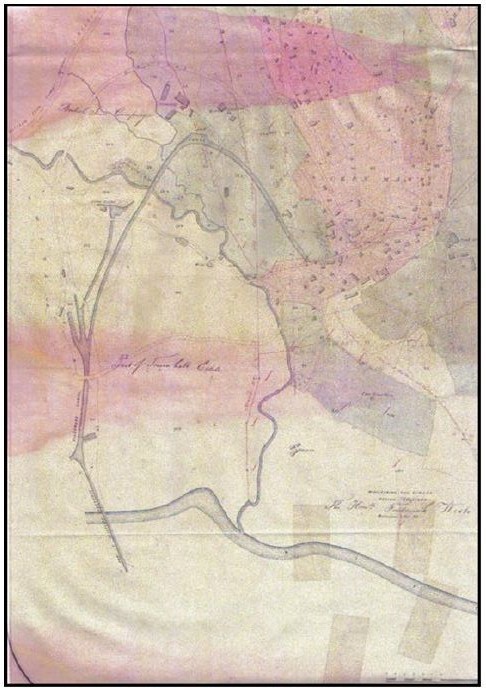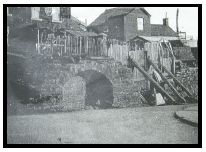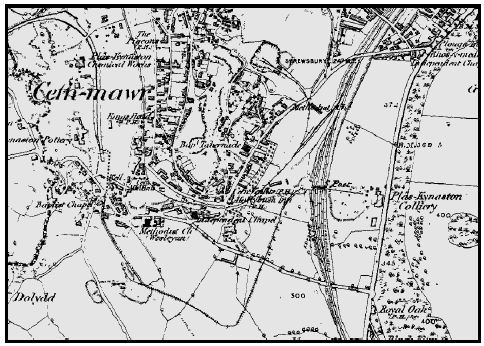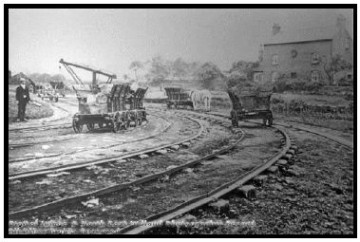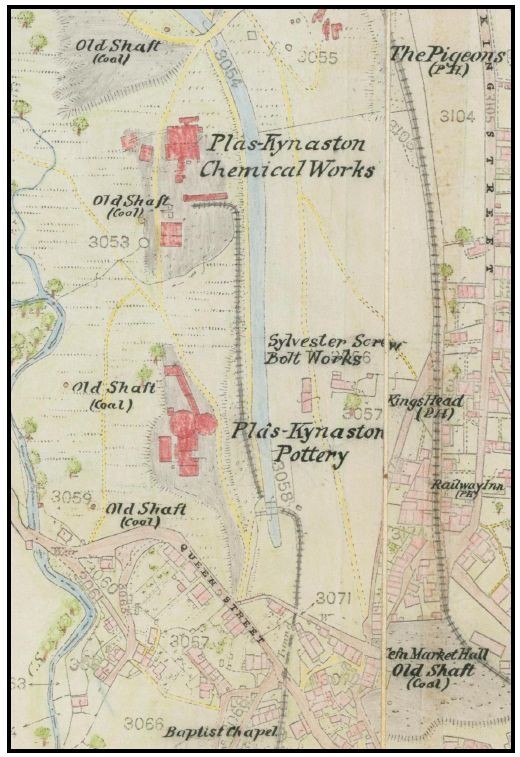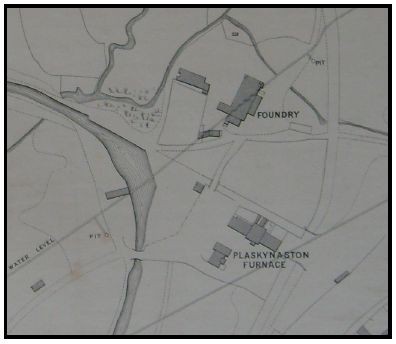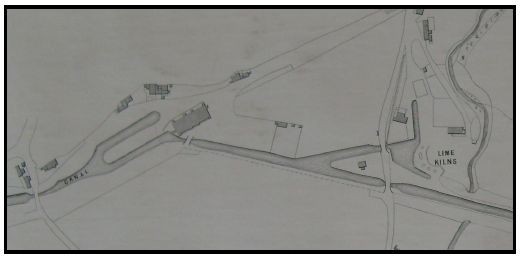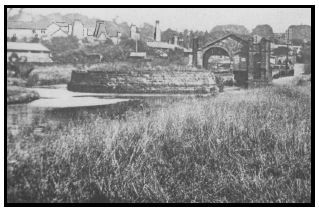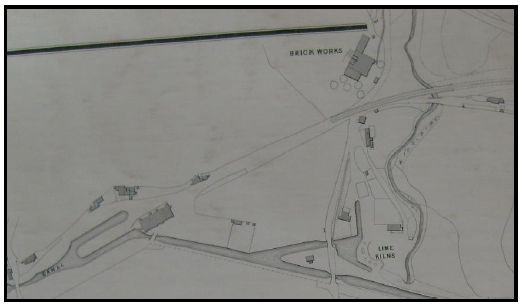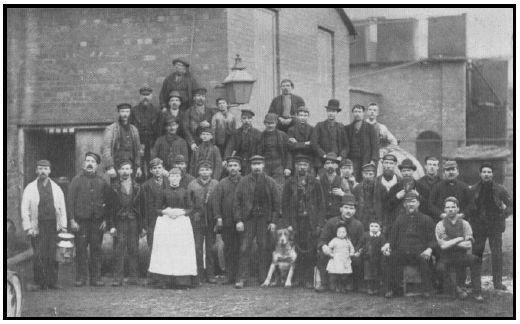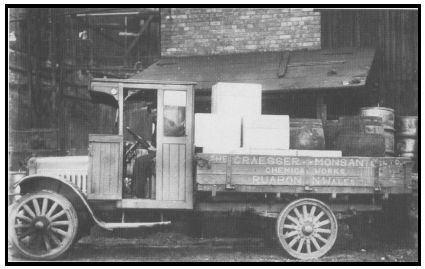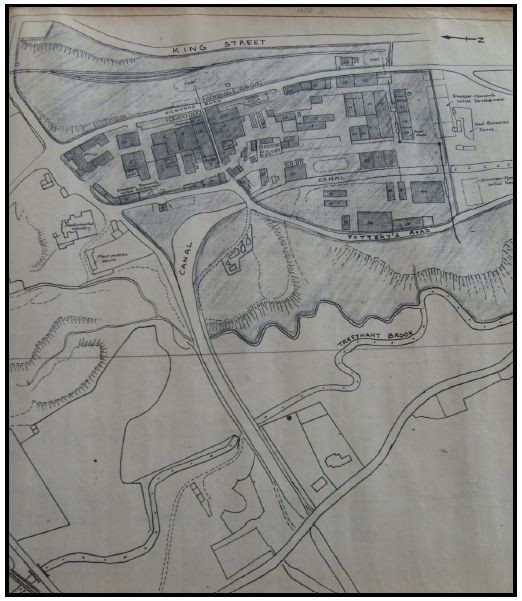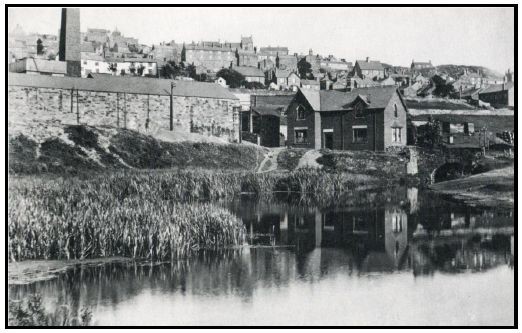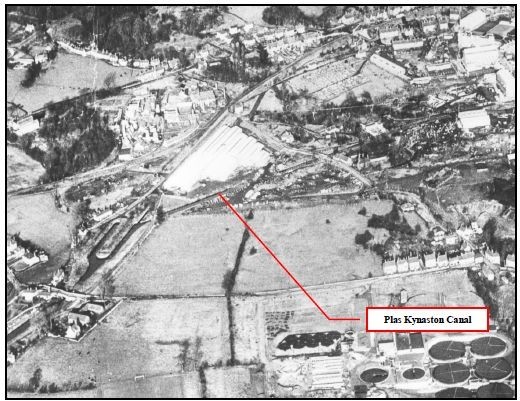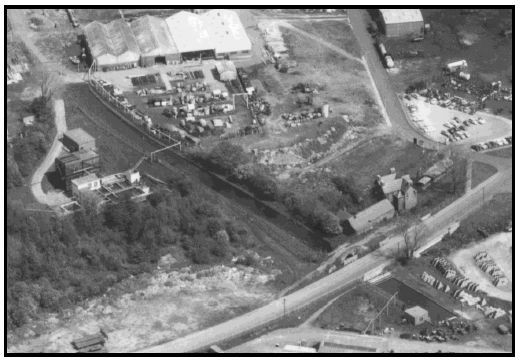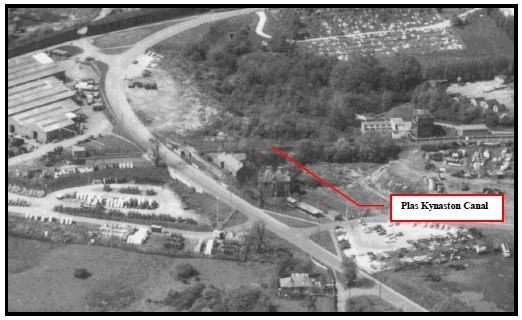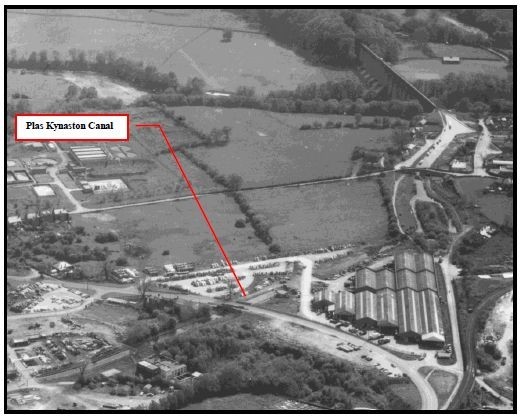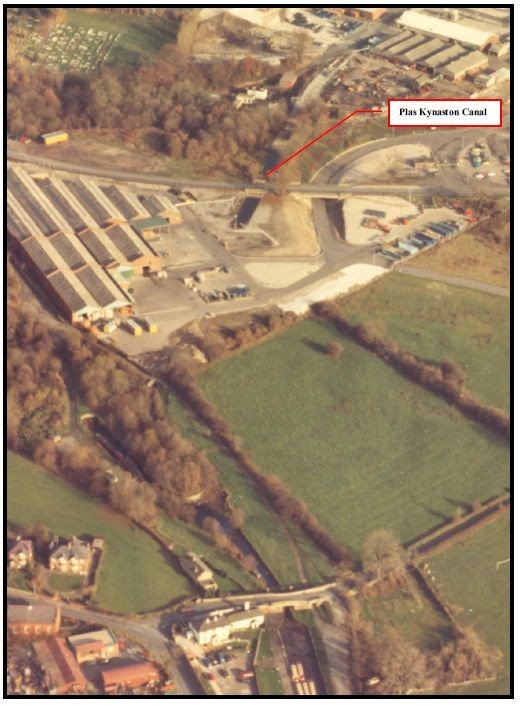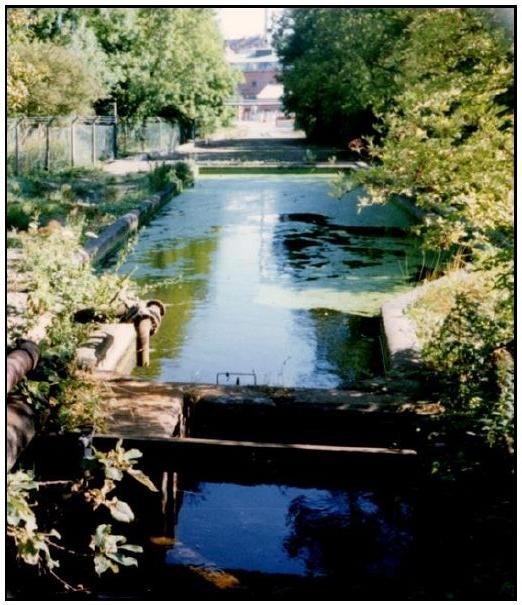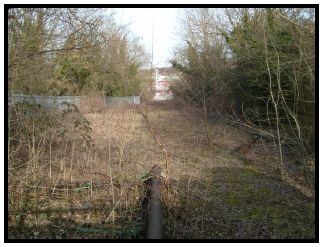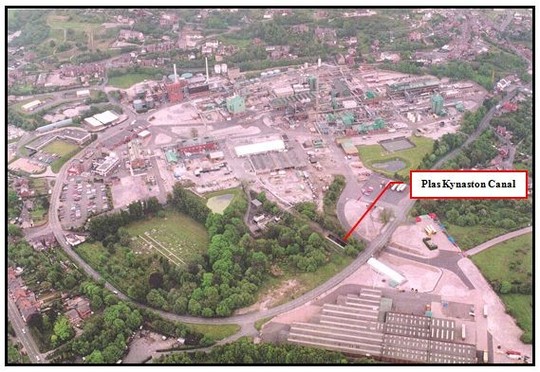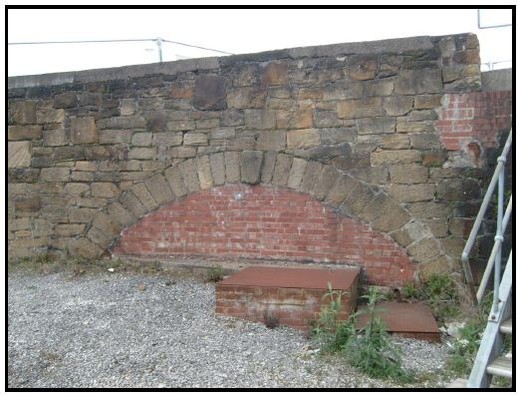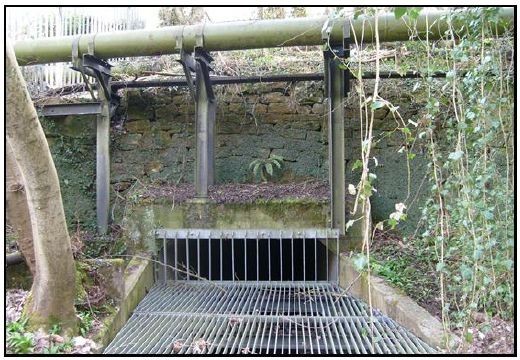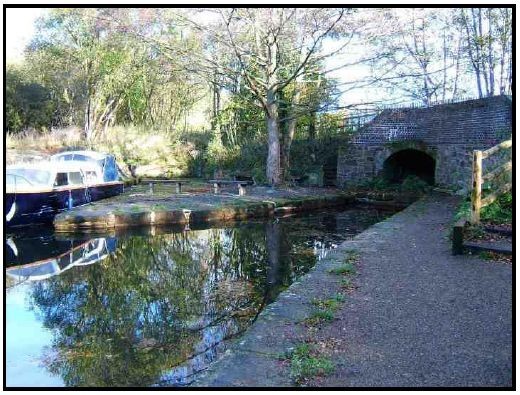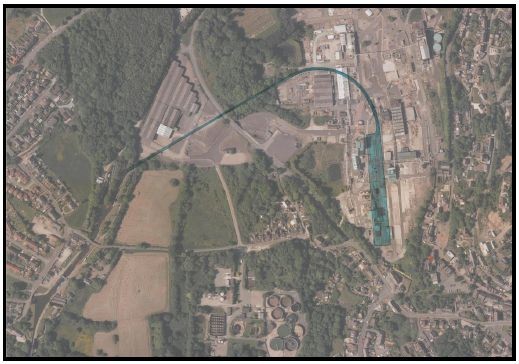The Plas Kynston Canal Story
The Plas Kynaston Canal, PKC was originally constructed in sections during the early 1800’s by both the Exuperius Pickering family and TE Ward to serve the coal, lime and iron making industries of Cefn Mawr. Original plans submitted show the branch extending from the Trevor Basin to the front of Plas Kynaston Hall
The original plan for the Plas Kynaston Canal as drawn up by Exuperius Pickering in 1820 and granted permission for by the Ellesmere & Chester Canal Company, note the line of the planned canal is shown in brown, on the plan. Also note the section already cut leading to the small basin / winding hole for the lime kilns, shown in blue extending from the Trevor Basin.
The planned route of the Plas Kynaston Canal in 1820, to the south of Plas Kynaston Hall and at the same elevation as the present Llangollen Canal and Pontcysyllte Aqueduct. This would have followed the proposed western route of the Ellesmere Canal as indicated in 1793, past the Plas Kynaston Hall to the south. The Plas Kynaston Canal was being cut to serve the Plas Kynaston Colliery which was sighted to the east of Plas Kynaston Hall, so that coal could be loaded directly for transport to the Plas Kynaston Foundry and Pottery or elsewhere along the canal network as required. The Plas Kynaston Canal and inland waterway network represented the principle transport system before the age of the steam driven railway engine.
An extract of the proposed 1793 Western Route for the Ellesmere Canal passing to the south side of Plas Kynaston Hall, at what has now become Cefn Mawr, Cefn.
The Plas Kynaston Hall, Cefn Mawr and the old stables can still be seen to the rear of the hall before they were demolished by the council when they had possession of the hall. Exuperius Pickering and his / their family once lived here while they were the Iron Masters following on from William Hazeldine at the Plas Kynaston Iron Foundry in Cefn Mawr.
This extract from the Plas Kynaston Estate and Colliery map by the Exuperius Pickering's predates the coming of the railways and shows the planned route of the Plas Kynaston Canal terminating at the rear of what would become the Queens Hotel in Cefn Mawr. This termination was probably due to the fact that the two major pits being sunk at that time were the Cefn Colliery and Plas Kynaston Colliery which could be connected to the canal by inclined and horse drawn railways.
This colour 1875 Ordnance Survey Edition is the clearest map of the Plas Kynaston Canal produced to date and it can be seen that the doubling up of branches from the Trevor Basin was rationalised. This then resulted in the extension of the Plas Kynaston Canal being continued from the pre-existing branch for the Lime Kilns.
The 1873 Ordnance Survey Edition shows the termination of the canal extended by what is probably best called the Plas Kynaston Railway leading through a short tunnel under the Queens Hotel in Cefn Mawr. This horse drawn railway line linked the Plas Kynaston Canal to the Plas Kynaston Colliery on the far side of the Plas Kynaston Hall.
The Plas Kynaston Canal and what the horse drawn Plas Kynaston Railway inter change with the Plas Kynaston Canal may have looked like for loading the barges with coal from the Plas Kynaston Colliery.
The Queens Hotel, Cefn Mawr under construction with the tunnel underneath that the Plas Kynaston Railway ran through connecting the Plas Kynaston Canal to the Plas Kynaston Colliery, the tunnel is to the left of the Queens Hotel as seen from the front.
The old railway tunnel seen from the back of the Queens Hotel being bricked up, this former entrance will now lie in the remains of the Monsanto Chemical Works. This is a short tunnel of approximately 30mts which opened out on to what is now Queens Street at the front of the Queens Hotel. Apart from being bricked up it is believed that the tunnel remains in tack
The below Ordinance Survey map shows the Plas Kynaston Canal coming into Cefn Mawr. The Plas Kyanston Canal is then linked to the Plas Kynaston Colliery on the eastward side of the main Chester to Shrewsbury Railway line, by the horse drawn Plas Kynaston Railway line to the south of Cefn Mawr.
The Plas Kynaston Colliery produced black shale as a by-product of coal extraction, and it was this black shale that first attracted RF Graesser, a German Industrial Chemist to Cefn Mawr in the 1860’s. He extracted paraffin oil and wax from the dark shale establishing the Plaskynaston Chemical Works in 1867. The Plas Kynaston horse drawn Railway then linked the Plas Kynaston Colliery with the Plas Kynaston Canal, Blast Furnace, Foundry, Pottery & Chemical Works.
The Plas Kynaston Pottery and Plas Kynaston Chemical Works served by the Plas Kynaston Canal and linked by the horse drawn Plas Kynaston Railway to the Plas Kynaston Colliery, coal and clay to feed the baking ovens of the Plas Kynaston Pottery and black shale and coal for the Plas Kynaston Chemical Works, all to be found in the Plas Kynaston Colliery, and finished products exported along the Plas Kynaston Canal! Also note the old shaft of the Cefn Colliery bottom right.
The Plas Kynaston Foundry and the Plas Kynaston Blast Furnace, used for the production of pig iron from the furnace and finished products from the foundry, all shipped out across one small item made at the Plas Kynaston Iron Foundry, the Pontcysyllte Aqueduct amongst other things, still in use today.
The Plas Kynaston Canal branching off from the Trevor Basin and the Lime Kiln Basin to the west of Trefynant Brook, also note the warehouse at Trevor Basin.
Trevor Basin in the 1920’s and the warehouse can be seen on the right hand branch of the Trevor Basin. In the distance the remains of JC Edwards Trefynant Clay works can be seen along with the new development of the Monsato Chemical works at that time. This was Monsanto’s first Chemical Plant in Europe.
The JC Edwards Trefynant Clay Works has also been referred to as the Plas Kynaston Potteries and covered 30 acres, to the west of Trefynant Brook, employing nearly 1,000 men during its heyday, however please note this is a separate pottery from that shown on the 1875 Ordnance Survey mapping, as this is west of Trefynant Brook.
The Brick Works to the west of Trefynant Brook and the start of JC Edwards and the Trefynant Clay Works, sometimes also referred to as the Plas Kynaston Pottery, despite the 1873 Ordnance Survey map showing the Plas Kynaston Pottery as being at the head of the Plas Kynaston Canal to the east of Trefynant Brook. If anyone has any more information on this would you please contact us.
Graesser’s Chemical Works, in 1879, R.F. Graesser had 29 employees, but by 1890 this had increased to 42 and 36 of them are shown in this photograph, with Edward Williams (Berwyn), manager for forty years, in the bowler hat in the front holding his children. The works dog, Gelert, was cared for by all the workmen. The woman is Mrs. Parker, the cleaner. By 1890, the New British Iron Works had closed and with it other ironworks dependent on it for their iron supplies such as the Tube Works near Graesser's Chemical Works. Gradually, Graesser enclosed these sites as his works expanded, which was most fortunate for the working population of Cefn and district. At this time too, JC Edwards' clay works at Trefynant also continued to expand.
Clove Shed at Graesser-Monsanto's Works, Cefn. R.F. Graesser collapsed working at his desk in 1911. The works continued under his son, Norman H. Graesser, and it became a limited company in 1916. Wages in 1912 ranged from 1s 2d. to 7d per hour. Under the works' manager, Edward Williams (Berwyn), the works was almost wholly self-sufficient with its blacksmith and tin-smith, carpenter and electrician. In 1920, the company became Graesser-Monsanto, and among the changes vanillin was manufactured. The sacks of cloves shown here were imported from Zanzibar and Madagascar. The clove oils were distilled to produce vanillin, which left a sweet taste in the atmosphere of the homes of the workers, and in 1922 half of the village of Cefn Mawr was occupied by the works' site and on goings.
Graesser & Monsanto Company Works Lorry, this open Star lorry with its solid tyres and a reputed maximum speed of 15 m.p.h. was a multi-purpose lorry at the Chemical Works in Cefn. It served not only to convey drums of chemicals to and from Acrefair Station, but also to transport the cricket and hockey players for their away-fixtures. MI. Queeny, the proprietor of Monsanto, the St. Louis Chemical Works, U.S.A., became a partner with R.F. Graesser of Cefn, and the company was then known as Graesser-Monsanto.
The Plas Kynaston Canal running through the Graesser Monsanto Chemical Works.
This extract of a hand drawn plan of the Graesser Monsanto Chemical Works at Cefn Mawr is dated 1920-1921. Monsanto expanded to Europe in 1919 by entering a partnership with Graesser's Chemical Works at Cefn Mawr, near Ruabon Wales, to produce vanillin, aspirin and its raw ingredient salicylic acid, and later rubber processing chemicals, and in 1928, Monsanto completed the purchase of the Cefn factory outright. The Plas Kynaston Canal continued to provide the water supply need for the spreading Monsanto Chemical works.
Ward's Wharf on the Plas Kynaston Canal, barges once came to this wharf and handled all kinds of merchandise - coal, ironstone, freestone, bricks and lime for fluxing for the Black Country furnaces, as well as food supplies for Cefn Mawr. The house in the centre of the photograph is Berwynfa, once serving as the manager's house and the office to the early chemical works which had been built by R.F. Graesser. Barges arrived at this wharf, in the early days, almost daily from the Midlands with loads of crude carbolic and cresylic acid.
The expanding Monsanto Chemical Works in the 1950’s andWardsWharfon thePlasKynastonCanalin Cefn Mawr when Monsanto was the major employer.
ThePlasKynastonCanalentering the Monsanto Chemical Works in the 1950s
The Plas Kynaston Canal became isolated fromTrevor Basin following new pumping stations being built on the River Dee, after the breach of theLlangollenCanalat Sun Trevor in 1945. This starved the plant of water for its operations so the Plas Kynaston Canal lost favour with Monsanto as the main water supply.
The Plas Kynaston Canal in the 1960’s, Windborne Gate Farm and the old bridge.
The Plas Kynaston Canal isolated from the Trevor Basin and the Pontcysyllte Aqueduct in by the new Monsanto warehouse site. The canal was filled in to provide an access road in the Beaching era and so continued the slow demise of the Plas Kynaston Canal in the wake of what was then seen as progress, i.e. road transport. Also note the new road bridge over the Plas Kynaston Canal.
The Plas Kynaston Canal in the Monsanto / Flexsys Works in 2001, still with water, and used as a fish hatchery. The short section between what remained of the Plas Kynaston Canal and the Trevor Basin can also be seen. The Plas Kynaston Canal clay bed still lies below the concrete of the Monsanto warehouses. However the main problem for the reinstatement of the canal is the new road bridge built by Monsanto in the 1960’s. This is currently to low and will need raising, however there is now plenty of scope for this as the following will show.
The last remaining section of the Plas Kynaston Canal (above) still in water, leading into the Flexsys (Monsanto) Chemical Works in 2005, shortly before this last section was filled in, note the narrowing abutment where the old bridge once stood.
The same section of the canal in 2013, eight years on after the demise of 90% of the former Monsanto Chemical works.
2004 The Monsanto Chemical Works renamed Flexsys in Cefn Mawr
2012 the former Monsanto, Flexsys & Solutia Chemical Works Site, now virtually just another vacant lot in the context of the continued devolution of British Industry.
The bridge where Berwynfa House once stood on the Plas Kynaston Canal with Wards Warf on the opposite side, with water in the manhole in picture.
The original sand stone bridge, built in the early 1800's carrying the Plas Kynaston Canal over Trefynant Brook with a concrete culvert installed by Monsanto in the 1960’s
The present entrance to what was once the Plas Kynaston Canal at the top of Trevor Basin, for all to see today when visiting the area. This could be the start of yet another saga in the story of the Plas Kynaston Canal.
The present entrance to what was once the Plas Kynaston Canal at the top of Trevor Basin, for all to see today when visiting the area. This could be the start of yet another saga in the story of the Plas Kynaston Canal.
The story of the Plas Kynaston Canal Story told in pictures and maps, please take a free copy of this web page, and all the best from the PKC Group.
Plas Kynaston Canal Story.pdf
Adobe Acrobat document [4.3 MB]
A well researched paper by Peter Brown on the Plas Kynaston Canal
Plas Kynaston Canal by P Brown.pdf
Adobe Acrobat document [166.7 KB]




